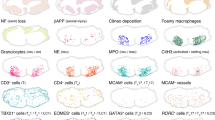Abstract
Delivering peptide-based drugs to the brain is a major challenge because of the existence of the blood-brain barrier (BBB). To overcome this problem, cell-penetrating peptides derived from proteins that are able to cross biological membranes have been used as cell-permeable and brain-penetrant compounds. An example is the transactivator of transcription protein transduction domain (Tat) of the human immunodeficiency virus. The basic domain of Tat is formed of arginine and lysine amino acid residues. Tat has been used as brain-penetrant carrier also in therapies for Alzheimer disease (AD), the most common form of dementia characterized by extracellular cerebral deposits of amyloid made up of Aβ peptide. The aim of our study was to assess whether Tat bind to amyloid deposits of AD and other amyloidoses. An in situ labeling using biotinylated Tat 48–57 peptide was employed in the brain tissue with amyloid deposits made up of Aβ (patients with AD and transgenic AD mice), of prion protein (patients with Gerstmann-Straussler-Scheinker disease), and other amyloidosis, processed by different fixations and pretreatments of histological sections. Our results showed that Tat peptide binds amyloid deposits made up of Aβ, PrP, and immunoglobulin lambda chains in the brain and other tissues processed by alcoholic fixatives but not in formalin-fixed tissue. The fact that biotinylated Tat peptide stains amyloid of different biochemical composition and the specific charge characteristics of the molecules suggests that Tat may bind to heparan sulfate glicosaminoglicans, that are present in amyloid deposits. Inhibition of the binding by Tat pre-incubation with protamine reinforces this hypothesis. Binding of Tat to amyloid deposits should be kept in mind in interpreting the results of studies employing this molecule as brain-penetrating compound for the treatment of cerebral amyloidoses. Our results also suggest that Tat may be helpful for the analysis of the mechanisms of amyloidogenesis, and in particular, the interactions between specific amyloid peptides and glicosaminoglicans.



Similar content being viewed by others
References
Feng S, Holland EC (1988) HIV-1 tat trans-activation requires the loop sequence within tar. Nature 334(6178):165–167. https://doi.org/10.1038/334165a0
Schwarze SR, Dowdy SF (2000) In vivo protein transduction: intracellular delivery of biologically active proteins, compounds and DNA. Trends Pharmacol Sci 21(2):45–48. https://doi.org/10.1016/S0165-6147(99)01429-7
Futaki S, Suzuki T, Ohashi W, Yagami T, Tanaka S, Ueda K, Sugiura Y (2001) Arginine-rich peptides. An abundant source of membrane-permeable peptides having potential as carriers for intracellular protein delivery. J Biol Chem 276(8):5836–5840. https://doi.org/10.1074/jbc.M007540200
Rizzuti M, Nizzardo M, Zanetta C, Ramirez A, Corti S (2015) Therapeutic applications of the cell-penetrating HIV-1 Tat peptide. Drug Discov Today 20(1):76–85. https://doi.org/10.1016/j.drudis.2014.09.017
Chang JR, Mukerjee R, Bagashev A, Del Valle L, Chabrashvili T, Hawkins BJ, He JJ, Sawaya BE (2011) HIV-1 Tat protein promotes neuronal dysfunction through disruption of microRNAs. J Biol Chem 286(47):41125–41134. https://doi.org/10.1074/jbc.M111.268466
Merlini G, Bellotti V (2003) Molecular mechanisms of amyloidosis. N Engl J Med 349:583–596
Glenner GG, Wong CW (1984) Alzheimer’s disease: initial report of the purification and characterization of a novel cerebrovascular amyloid protein. Biochem Biophys Res Commun 120(3):885–890. https://doi.org/10.1016/S0006-291X(84)80190-4
Ghetti B, Piccardo P, Frangione B, Bugiani O, Giaccone G, Young K, Prelli F, Farlow MR et al (1996) Prion protein amyloidosis. Brain Pathol 6(2):127–145. https://doi.org/10.1111/j.1750-3639.1996.tb00796.x
Dispenzieri A, Merlini G (2016) Immunoglobulin light chain systemic amyloidosis. Cancer Treat Res 169:273–318. https://doi.org/10.1007/978-3-319-40320-5_15
Linke RP (2000) Highly sensitive diagnosis of amyloid and various amyloid syndromes using Congo red fluorescence. Virchows Arch 436(5):439–448. https://doi.org/10.1007/s004280050471
Conti CJ, Larcher F, Chesner J, Aldaz CM (1988) Polyacrylamide gel electrophoresis and immunoblotting of proteins extracted from paraffin-embedded tissue sections. J Histochem Cytochem 36(5):547–550. https://doi.org/10.1177/36.5.3282007
Giaccone G, Canciani B, Puoti G, Rossi G, Goffredo D, Iussich S, Fociani P, Tagliavini F et al (2000) Creutzfeldt-Jakob disease: Carnoy’s fixative improves the immunohistochemistry of the proteinase K-resistant prion protein. Brain Pathol 10:31–37
Rusnati M, Coltrini D, Oreste P, Zoppetti G, Albini A, Noonan D, d’Adda di Fagagna F, Giacca M et al (1997) Interaction of HIV-1 Tat protein with heparin. Role of the backbone structure, sulfation, and size. J Biol Chem 272:11313–11320
Lindahl B, Lindahl U (1997) Amyloid-specific heparan sulfate from human liver and spleen. J Biol Chem 272(42):26091–26094. https://doi.org/10.1074/jbc.272.42.26091
Wall JS, Richey T, Stuckey A, Donnell R, Macy S, Martin EB, Williams A, Higuchi K et al (2011) In vivo molecular imaging of peripheral amyloidosis using heparin-binding peptides. Proc Natl Acad Sci U S A 108(34):E586–E594. https://doi.org/10.1073/pnas.1103247108
Author information
Authors and Affiliations
Corresponding author
Rights and permissions
About this article
Cite this article
Maderna, E., Colombo, L., Cagnotto, A. et al. In Situ Tissue Labeling of Cerebral Amyloid Using HIV-Related Tat Peptide. Mol Neurobiol 55, 6834–6840 (2018). https://doi.org/10.1007/s12035-018-0870-x
Received:
Accepted:
Published:
Issue Date:
DOI: https://doi.org/10.1007/s12035-018-0870-x




